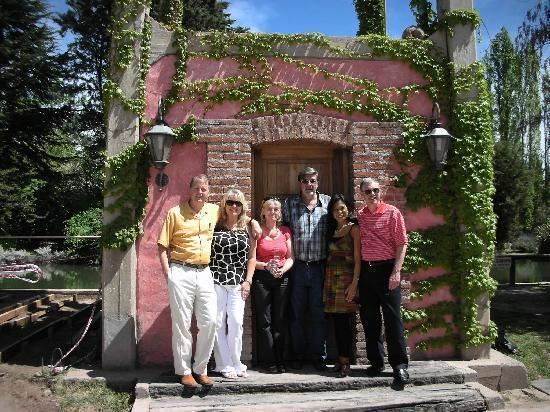Elevation 902 m (2,959 ft) Climate BWk | Postal Code M5664 Local time Wednesday 4:55 PM Population 5,600 (2001) | |
 | ||
Weather 22°C, Wind N at 19 km/h, 24% Humidity | ||
Chacras de Coria is a small town located in an oasis in the north of the province of Mendoza, Argentina, a few kilometers from the capital city.
Contents
Map of Chacras de Coria, Mendoza Province, Argentina
Due to its characteristics of a micro-climate during summer months, the area is popular for recreation. It relies on tourism generated through its wineries and museums, things which have resulted in a busy food pole and variety.
History
The city of Chacras de Coria has a story that starts in the year 1568, with the marriage of Juan de Coria Bohórquez and Beatriz Yánez Palma. This couple had nine children, one of whom was Juan Hilario.
Other authors argue that in 1576, Alonso de Reinoso received a land grant title to 4 miles (18 km) from the city, where they planted for the Inca, and asserts historian Juan Isidro Maza, the farms had originated in a royal grant which gave Juan Hilario Coria Yañez the land called by the natives as Lanyení (hollow).
Juan Hilario (son of John and Beatrice) married Francisca Jimenez, who has denied in his will (1650) that John has made any capital and inherits his property to his first son, Alonso Coria Jiménez. In 1656, he married Beatriz Alonso Gomez Pardo, and 5 years later, taking a loan of $800 to parents Mercedarios to census the inherited, which was considered as "common knowledge (...) as valuable and plentiful estate. After Ali's death and set aside land Francisca Jimenez (his mother) to his son Francis, reads his will, which says that John Hilario had brought as dowry, a property of 100 blocks (157 ha).
In 1724, dies Francis, son of Alonso. In that same year, if all land were added to all the brothers, the farms ranged from ditch to the hills and the Rio Mendoza Godoy Cruz. For 1757, carried out enforcement of the debt of $500 with Mercedarios parents and pass their hands about 16 blocks. Thus arises the chacarilla of Mercy.
For 1812, Farms has 344 inhabitants, of whom about 150 live in the present Godoy Cruz. In 1855 he presents the budget of hand, scarp and trench. Two years later, the school tax Chacras Coria had 67 students in reading and 57 writing. In 1861, 20 March, was the great earthquake that destroyed the church and the schoolhouse Mercedarios. After 7 years, calls for the creation of a school for girls that could be enjoyed by more than 80 of them. On 30 January 1889, establishing a police station by decree of the province. In 1893, the Farms station is named "Paso de los Andes".
Farms can say that as we know today would not have been possible only thanks to Don Jose de Mazzolari who donated land for the location of the square, adjacent streets, the church and the police building. On May 25, 1903, it opened the square "General Jerome Espejo, sponsored by Mr. and Mrs. Mazzolari, Light Balmaceda, Zida Zotelo, Mr. Fernandez Cabrera, Mr. Alvarez, Alberto Aguinaga and Mr. Ricardo Deromedis. The station was opened in 1908 and the Biblioteca Popular Mariano Moreno, a year later. In 1910 he completed the vestry, and from that year until 1915, you get the installation of electric current through the intervention of the Municipal Commission. In 1914, the Executive appoints Gregory Amaya as manager of the Civil Registry. The launch of the 1st aid room was not until 1920 and had its own building, new in 1931, ceded by Miguel de Aguinaga. On 1 October 1935, was inaugurated and blessed the parish church of "Perpetual Help. The 1940s was a time of change. With the rise of the chemical industry, factories were located in Farms. There was some as Carbometal, Paul Casale, Viplastic and others. In 1975, with the crisis in wine, the vine no longer a good business, and the vines are replaced by summer homes and weekend. We can say that from now on is when the problem began that concerns us and we'll see in this practical.
Farms in 1980 had 3054 inhabitants and had a growth rate of 1% annually, but in 1991, it only had about 5,000 inhabitants, and the growth rate had increased to 4.4% per year. It has now grown tremendously and its urban landscape in all its aspects with emphasis on food and recreation.
